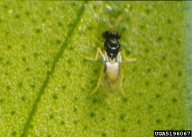
Photo from wikipedia
Abstract The Asian citrus psyllid, Diaphorina citri, is a significant economic pest of citrus because it vectors a bacterium that causes the lethal citrus disease huanglongbing. From 2015 to 2016,… Click to show full abstract
Abstract The Asian citrus psyllid, Diaphorina citri, is a significant economic pest of citrus because it vectors a bacterium that causes the lethal citrus disease huanglongbing. From 2015 to 2016, digital video recorders were used to identify natural enemy species attacking sentinel immature D. citri colonies deployed monthly at three urban sites in southern California. Natural enemy activity during both daylight and nighttime hours was recorded. To examine the impact of ant-hemipteran mutualisms on biological control efficacy, we compared natural enemy interactions with D. citri colonies that were either fully exposed or protected from walking arthropods with a sticky barrier. Spiders (Aranae), syrphid larvae (Syrphidae), predatory mites (Phytoseiidae), green lacewing larvae (Chrysopidae), thrips (Thripidae), and the introduced parasitoid, Tamarixia radiata, were the dominant natural enemy groups visiting immature D. citri colonies over the course of the study. A significant proportion of syrphid and green lacewing larvae, and T. radiata visits to the sentinel colonies resulted in D. citri attacks. Spiders rarely attacked immature D. citri. Argentine ants, Linepithema humile, were the most common arthropod visiting D. citri colonies across all study sites and ants were active day and night. When ant access to D. citri colonies was restricted, natural enemy abundance and attack rates increased, particularly those by syrphids and T. radiata. This study highlights the importance of natural enemies and ant-psyllid interactions in the biological control of D. citri in urban citrus ecosystems. Therefore, conservation of natural enemies and ant control should be considered for the sustainable management of this pest-disease complex.
Journal Title: Biological Control
Year Published: 2017
Link to full text (if available)
Share on Social Media: Sign Up to like & get
recommendations!